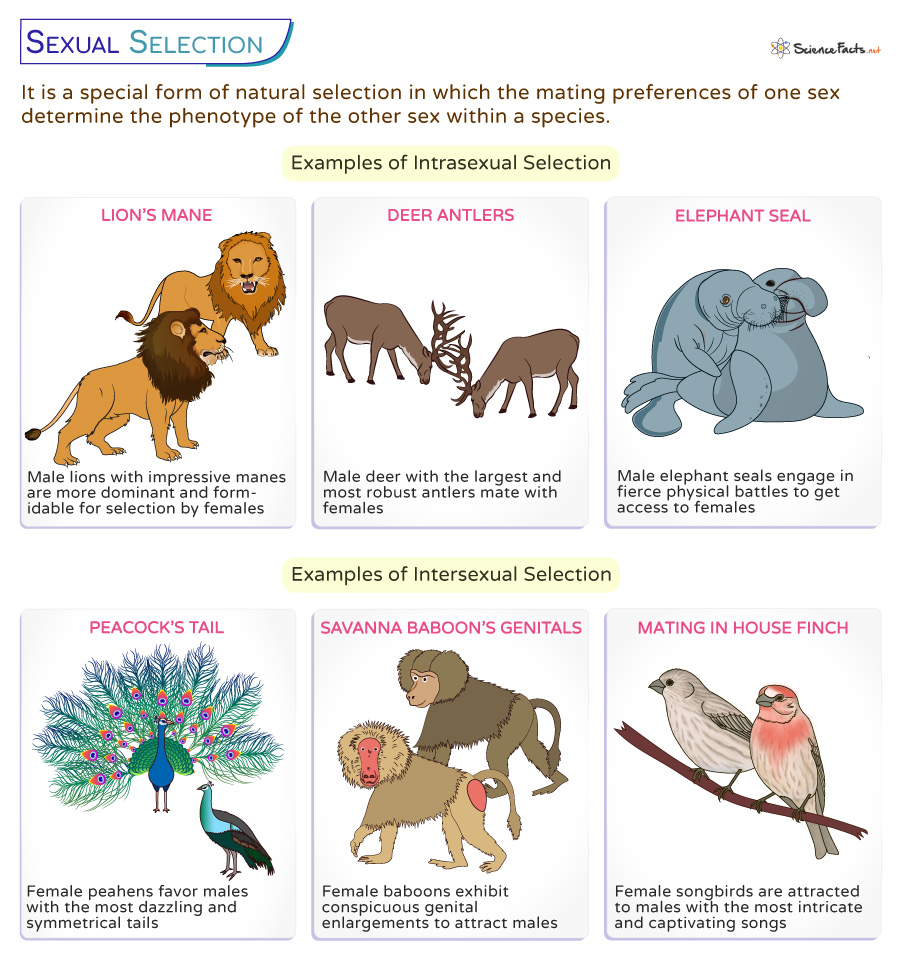Unlike the different types of natural selection, which focus on an organism’s survival and ability to pass on its genes, sexual selection depends on an individual’s reproductive success.
Darwin’s Theory of Sexual Selection
Types of Sexual Selection
Examples of Sexual Selection
Why Does Sexual Selection Occur
The theory of sexual selection put forward by Darwin has met with both intrigue and skepticism since its inception. However, as more evidence accumulated, it gained widespread acceptance. Subsequent generations of scientists expanded upon Darwin’s ideas, showing the role of sexual selection in various species and shedding light on the evolution of numerous secondary sexual characteristics.
Intrasexual Selection
Lion’s Mane Male lions are known for their majestic manes, which can vary in size and color. Male lions with impressive manes are often seen as more dominant and formidable by other males. They are more likely to be selected by females for mating. Deer Antlers In deer, male antlers serve as formidable weapons during intrasexual selection. These antlers are shed and regrown each year. During the mating season, male deer engage in physical combat to establish dominance. The males with the largest and most robust antlers often win these battles and gain access to females. Elephant Seal Male elephant seals engage in fierce physical battles with their fellow male members in an area to establish their supremacy over others. The successful male gets access to mating with the females residing there. Bird Songs Many male bird species engage in complex and melodic songs, particularly during the breeding season. Female birds are attracted to males with the most intricate and captivating melodies. These songs are a sign of physical fitness and indicate that the male can defend a territory and provide food for offspring.
Intersexual Selection
Peacock’s Tail Male peacocks have incredibly ornate and colorful tail feathers displayed in intricate courtship dances. These displays are meant to attract females. Peahen females, conversely, are highly selective, favoring males with the most dazzling and symmetrical tails. By choosing mates with impressive tails, female peafowls indirectly select for good genetic quality, as only healthy and well-nourished males can afford to grow such extravagant plumage. Savanna Baboon’s Genitals Female baboons exhibit conspicuous genital enlargements known as ‘sexual swellings.’ Male baboons prefer mating, with females displaying the most pronounced swellings, often seen as potential indicators of heightened fertility. Courtship Displays in Birds of Paradise Male birds of paradise, found in New Guinea, are renowned for their elaborate courtship displays. These displays involve intricate dances and the flaunting of vibrant plumage. Females are highly selective and prefer males with the most extravagant displays. These displays indicate genetic fitness and the male’s ability to provide for offspring. Fitness in Humans In humans, sexual selection is not limited to the animal kingdom. People often choose mates based on physical attractiveness, including facial symmetry, body proportions, and clear skin. Beyond physical traits, human chooses their mate based on personality characteristics, intelligence, sense of humor, and other behavioral traits.
Good Genes Hypothesis suggests that individuals with attractive traits may have better genes, leading to healthier offspring. By choosing a mate with these attractive traits, the selecting individual increases the chances of having healthy and genetically fit offspring.Fisherian Runaway Selection proposes that once a preference for a particular trait exists in a population, it can reinforce itself over time. In this scenario, individuals with the desired quality become preferred mates simply because they possess the trait, leading to a self-perpetuating selection cycle.
